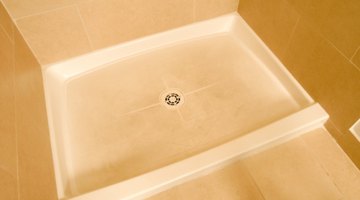The Average Cost to Move a Shower Drain
Two of the costliest home improvement repairs involve plumbing modifications and electrical work. Both require specialists with knowledge, training and experience to do the work and equipment to facilitate the job. Moving a shower drain involves obtaining construction permits and locating specialized and licensed workers. If the current drain system fails to meet building standards and codes, the job involves additional costs, and modification to the shower and the drainage system.

Distance of the Move
The distance from the original drain to the new drain location helps to determine the cost of the move. Drilling through floor joists or replacing structural supports to relocate the drain means hiring a construction engineer to inspect the plans for safety. Construction also includes hiring a carpenter to drill boards and reconfigure flooring. Homes with a slab--or concrete--foundation require use of a jackhammer to remove the foundation along the path of the new drain. The mean hourly wage for a plumber in 2010 was $24.21, according to the U.S. Bureau of Labor Statistics (BLS). Carpenters averaged $18.24 an hour for the same year, and concrete workers earned an average hourly wage of $17.67. Calculating the exact number of hours to move a drain requires removing the flooring and examining the drain and pipes. The cost for a move performed by a homeowner, including the fees for renting the appropriate tools, begins at several hundred dollars. Jobs involving more complex drain reconfigurations requiring replacement of structural supports begin at $1,000. Quadruple the figures when hiring professionals.
Meeting Local and County Codes
Drains in older homes may fail to meet modern plumbing codes, but new construction projects must meet the current codes. This means major changes in homes with older plumbing systems with lead, asbestos or old ceramic drainpipes. Pipes with asbestos require removal procedures using special technicians who must obtain hazardous removal permits. Relocating the drain, even without the special considerations, requires obtaining a construction permit and payment of a fee set by your locality.
Shower Amenities
Moving the drain in a shower with a plastic shower pan or plastic shower enclosure includes removing the unit and moving the drain. Doing the same drain movement in a shower with tile and grout flooring requires tearing up the ceramic flooring to move the drain. The cost to replace the ceramic or purchase a new plastic or ceramic shower pan adds significant costs to the drain relocation. A basic shower pan costs approximately $100 in 2011. Tile installers work by the project, with an average hourly wage of $20.87 in 2008, according to the BLS. The cost for retiling a shower depends on the size and the complexity of the tile selection and design. The cost for tile shower floor replacement for DIYers runs less than $200 for tiles and tile saw rental. Triple the costs for professional replacement in 2011.
Resource #4
Geographic Pricing
The average cost of plumbing and construction workers varies with the geographic location of the home and the number of licensed plumbers, tile layers, contractors and construction workers in the immediate region. Plumbers in California, Nevada and the Pacific Northwest, for instance, earned significantly more than plumbers in Utah and Wyoming. East Coast plumbers in New York and New Jersey earned more than their counterparts in Ohio, Maine and Vermont. Plumbers in Florida and the Carolinas earned the lowest average salary in the nation in 2010. The geographic location of the drain impacts the cost of a move performed by professionals.
References
- "This Old House"; Hiring a Qualified Plumber; Danny Lipford
- Bureau of Labor Statistics; Occupational Outlook Handbook, 2010-11 Edition; Plumbers, Pipelayers, Pipefitters, and Steamfitters
- Bureau of Labor Statistics; Occupational Employment and Wages, May 2010; Plumbers, Pipefitters, and Steamfitters
- Bureau of Labor Statistics; Occupational Employment and Wages, May 2010; Carpenters
- Bureau of Labor Statistics; Career Guide to Industries, 2010-11 Edition; Construction
- Environmental Protection Agency; Asbestos in Your Home; If You Hire a Corrective-Action Contractor
Writer Bio
Lee Grayson has worked as a freelance writer since 2000. Her articles have appeared in publications for Oxford and Harvard University presses and research publishers, including Facts On File and ABC-CLIO. Grayson holds certificates from the University of California campuses at Irvine and San Diego.
Photo Credits
- Jupiterimages/Photos.com/Getty Images
- Jupiterimages/Photos.com/Getty Images
More Articles



